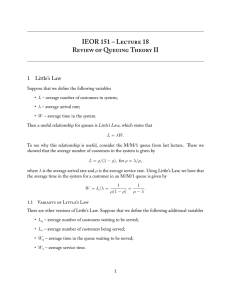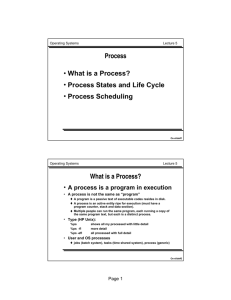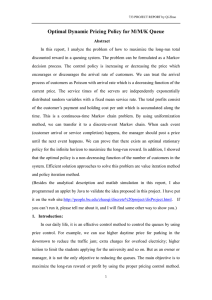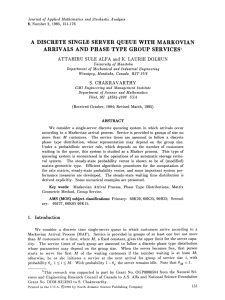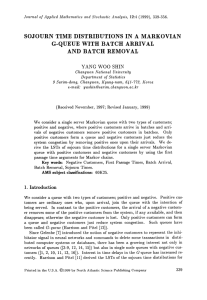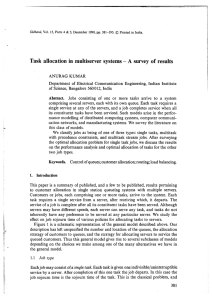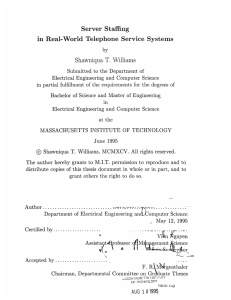IEOR 151 – Lecture 21 Little’s Law 1
advertisement
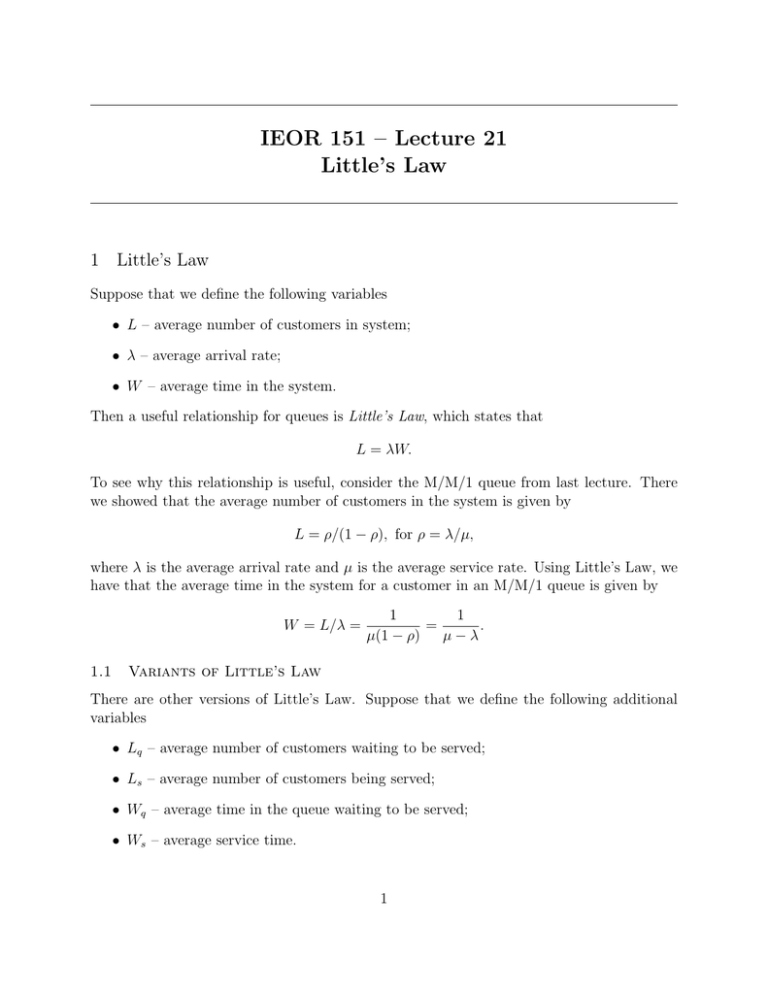
IEOR 151 – Lecture 21 Little’s Law 1 Little’s Law Suppose that we define the following variables • L – average number of customers in system; • λ – average arrival rate; • W – average time in the system. Then a useful relationship for queues is Little’s Law, which states that L = λW. To see why this relationship is useful, consider the M/M/1 queue from last lecture. There we showed that the average number of customers in the system is given by L = ρ/(1 − ρ), for ρ = λ/µ, where λ is the average arrival rate and µ is the average service rate. Using Little’s Law, we have that the average time in the system for a customer in an M/M/1 queue is given by W = L/λ = 1.1 1 1 = . µ(1 − ρ) µ−λ Variants of Little’s Law There are other versions of Little’s Law. Suppose that we define the following additional variables • Lq – average number of customers waiting to be served; • Ls – average number of customers being served; • Wq – average time in the queue waiting to be served; • Ws – average service time. 1 Then, we also have Lq = λWq Ls = λWs . Also, note that because the average time in the system is the average time spent waiting to be served and the average serving time, we have that W = Wq + Ws Again returning to the example of the M/M/1 queue from last lecture, we have that Ls = λ/µ = ρ µ − (µ − λ) ρ = (µ − λ)µ µ−λ 2 ρ ρ Lq = λWq = = . 1/ρ − 1 1−ρ Wq = W − 1/µ = 2 M/M/s Queue with s Lines Now, we turn our attention to a Markovian queue with s servers, average arrival rate λ, and average service rate for each queue of µ. First, we examine the situation in which there is a single line for each server. This is the situation at, for instance, Safeway. In our model, we will assume that each customer randomly chooses a line. Then, this is simply s distinct M/M/1 queues with average arrival rate λ/s and average service rate of µ, for each queue. Using the results for M/M/1 queues we have that λ/µ λ/(sµ) = L=s 1 − λ/(sµ) 1 − λ/(sµ) 1 W = . µ − λ/s 3 M/M/s Queue with One Line Now, we turn our attention to a Markovian queue with s servers, average arrival rate λ, and average service rate for each queue of µ. Here, we examine the situation in which there is a single line. This is the situation at, for instance, Fry’s Electronics or the baggage check-in line for an airline at the airport. Some math gives that ρ C(s, ρ) + sρ 1−ρ C(s, ρ) 1 W = + , sµ − λ µ L= 2 where C(s, ρ) = (sρ)s 1 s! 1−ρ Ps−1 (sρ)k (sρ)s 1 k=0 k! + s! 1−ρ is the probability that all servers are occupied. An approximation is that √ λ ( sµ ) 2(s+1)−1 1 Wq ≈ · λ µ s(1 − sµ ) It is interesting to compare an M/M/s queue with one line to an M/M/s queue with s lines. The time spent in an M/M/s queue with s lines is longer than the time spent in an M/M/s queue with one line. The intuition is that having just one line allows for greater utilization of all s servers. 4 M/M/∞ Queue Some systems are modeled using an infinite number of servers. In this model, the service rate is state-dependent and is given by nµ where n is the number of customers in line, and µ is the service rate for a single customer. Some calculations give that L = λ/µ and W = 1/µ. 5 More Information and References The material in these notes follows that of the course textbook “Service Systems” by Mark Daskin and of the Wikipedia article on “Poison process”. 3




